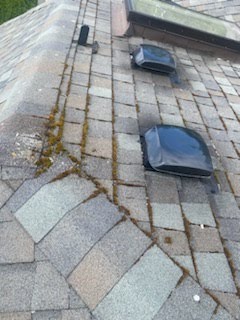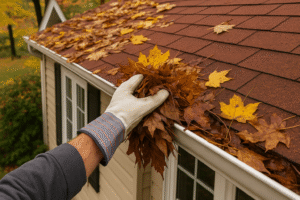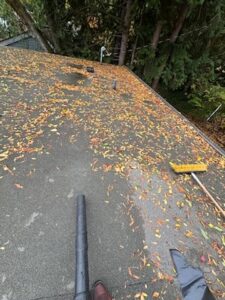Severe storms are becoming more common, leaving many homeowners concerned about wind damage roof issues and the risk of losing shingles in high winds. Choosing the right roof design and materials can greatly reduce wind damage roof shingles problems and extend the life of your home’s most important barrier.
In this guide, you’ll learn which roof styles hold up best, what shingles provide better resistance, and how to protect your home before and after a storm.
For storm‑related tips, explore:
Storm Survival: What to Do After a Storm Damages Your Roof
Importance of Ice and Water Shield in Roofing
Why Roof Design Matters for Wind Damage Protection
Your roof’s shape and structure influence how wind flows across it. Designs that reduce exposed edges and uplift forces experience far fewer wind damage roof shingles problems. Choosing a wind‑resistant design can save you from costly repairs after severe storms.
How Wind Affects Roofs in the Puget Sound Region
In the Puget Sound area, unique coastal weather patterns create strong gusts that put extra stress on roofs. Winds channeled through inlets and over hills can cause uplift, loosen fasteners, and lead to wind damage roof concerns. Homeowners frequently notice missing or curled shingles after fall and winter storms, making wind damage roof shingles a common issue in this region. Combined with heavy rain, any exposed underlayment can quickly lead to leaks and structural problems. For homes in the Pacific Northwest, investing in wind‑resistant shingles and proper installation is essential.
Roof Types That Withstand High Winds
Hip Roofs
Hip roofs slope on all four sides, creating an aerodynamic shape that reduces uplift and minimizes wind damage roof risks. With fewer vulnerable edges, shingles remain secure even during strong storms.
Reinforced Gable Roofs
A gable roof, when properly braced and fitted with storm‑rated shingles, can also handle high winds. Reinforcements along the ridge and eaves are key to avoiding wind damage roof shingles.
Metal Roofing Systems
Metal panels interlock tightly, forming a continuous surface that resists uplift. This makes metal roofing a popular choice in regions prone to wind damage roof problems.

Shingle Options That Resist Wind Damage
Architectural Asphalt Shingles
These thicker shingles are engineered to withstand higher wind speeds, helping to reduce wind damage roof shingles and maintain a cleaner roofline after storms.
Impact‑Resistant Shingles
Designed to resist both wind and debris, these shingles are an investment that protects against storm‑related damage.
Ice and Water Shield Protection
Even with durable shingles, underlayment matters. A high‑quality ice and water shield creates a secondary barrier, helping prevent leaks if shingles are lost.
Learn more: Importance of Ice and Water Shield in Roofing
How to Prevent Wind Damage Roof Shingles Issues
Regular Inspections
Check for loose or aging shingles regularly. Preventive maintenance reduces the chance of wind damage roof shingles during storms.
Reinforce Flashing and Fasteners
Ensure your roofing system uses wind‑rated fasteners and properly installed flashing to secure edges and vulnerable areas.
Immediate Action After a Storm
If you see missing shingles or leaks, act quickly to prevent further wind damage roof problems.
See also: Storm Survival: What to Do After a Storm Damages Your Roof
Final Thoughts on Protecting Against Wind Damage Roof Problems
Selecting a roof type and shingles that resist wind isn’t just a smart upgrade—it’s essential protection against costly repairs. From hip roofs to impact‑resistant shingles, these solutions help homeowners avoid wind damage roof issues and keep roof shingles secure even in extreme weather.
Ready to protect your home from wind damage?
👉 Contact Orca Roofing today for expert guidance on wind‑resistant materials, professional inspections, and proven solutions that keep your roof secure in the Puget Sound climate.


